![]()
|
The
Britannia Pottery |
Location and period of operation:
|
The Britannia Pottery |
Hanley |
? |
Aug 1892 |
|
Joseph Gray & Son |
Hanley |
Aug 1892 |
c. 1923 |
|
Earthenware manufacturer at the Britannia Pottery, William Street, Hanley, Stoke-on-Trent, England
NOTE: There were a number of other (unrelated) potworks using the name 'Britannia') |
The
London Gazette
19th August 1892
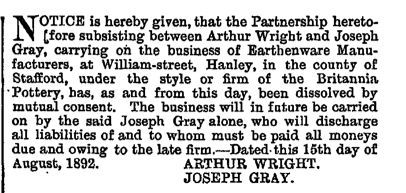
notice of the dissolution
of the partnership
between Arthur Wright and Joseph Gray
| William
Street (off Broad Street) Hanley
Note the misspelling of 'Gray' |
Princes
Road (off Penkhull Street) Penkhull, Stoke-upon-Trent
Gray, Jos., manufacturer |
from: 1907 Staffordshire Sentinel
'Business Reference Guide to The Potteries, Newcastle & District'
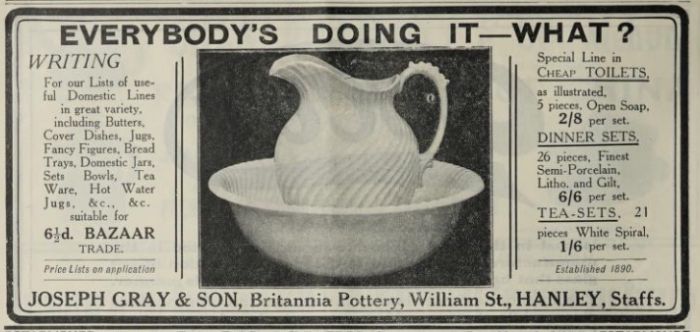
Joseph Gray & Son,
Britannia Pottery, William St., Hanley, Staffs
The Pottery Gazette - 1st January 1913
1913
advertorial for Joseph Gray & Son
|
"Joseph Gray & Son, Britannia Pottery, William -street, Hanley, are earthenware manufacturers who have laid themselves out specially to provide goods capable of meeting the needs of the million, and to do this their prices have, of course, been fixed within the reach of all. Their trade is of a widely miscellaneous character, and the variety of the articles they manufacture has, doubtless, had much to do with their extensive connection with the bazaars, who can find probably all the miscellanea they require in the productions of the Britannia Pottery. The firm has evidently found this miscellaneous type of business to best suit their needs, and have preferred to develop it, rather than embark upon the manufacture of specific services. There is probably a valid reason why their productions are out of the range of competition in the matter of price. They have such a demand for individual articles that they are able to give their workmen standing orders to make individual lines, thus securing the maximum advantages in the direction of production, and the marketing of the goods with a minimum of salesmanship. One would imagine that at the prices asked for them the majority of the goods will sell themselves ; certainly those engaged in the retailing of the cheaper lines are able to handle Gray & Sonís productions in large volume, particularly in the home market. The productions of this pottery are of such a cosmopolitan type that it would be out of the question to attempt to specify even the bulk of them in a short notice of this description, but we may venture to enumerate a few of them. Such articles as lipped bowls, bakers, jugs, covered butters, bread trays, pastry bowls, lettered domestic jars, vegetable dishes, joke cups and saucers, fancy figures, and similar lines are amongst some of the most saleable. Earthenware teas and saucers sell in notable quantities, and may be had either plain or fluted, with supplementary articles, such as muffins, in the same shapes. A new "Paris" shape tea and saucer, of a very useful size, and having a deep saucer, is proving itself popular, and receives generally a gold band with two gold lines. In ornamentals and grotesque figures there is a wide assortment ; the animals include cats, dogs, horses, &c., and some of the models are specially well done, particularly the Scotch terrier. There is also a new line in Jester faces, a new Toby jug, and a a new snuff-taker. For some time the firm has been specially catering for a toilet trade, and they have some remarkably cheap lines in the five-piece set with open soap, and the six-piece set with covered soap, in their "Naples" shape. This is supplied in different coloured shadings, and it may safely be said that it is amongst the cheapest lines on the market. Shaded and vellumed toilets with floral litho subjects are to be had in blue, pink, fawn, &c., on a tall slender shape known as the "Cairo", and the same shape can also be had with wide bands of different colours or gold band and lines round the centre of the pieces. The firm ís toilet trade has developed extensively of late, and toilet ware is now shipped by them from the factory in truck loads, especially in the plain shaded. A wide trade is done also in mounted jugs, which can be had either plain or embossed, with the ordinary common metal mount, in pint, pint and a-half, and quart sizes. The "Lindsay" wheat embossed white earthenware enjoys a good run, and is made in jugs in four sizes from 24ís to 42ís, in teapots from 24ís to 36ís, in quart hot water jugs and quart coffee pots, either with pitcher or metal covers, and other lines. We illustrate a few pieces indicating readily selling lines ; a catalogue and lists can be had from Gray & Son by application to the Britannia Pottery."
Pottery Gazette and Glass Trade Review, July 1913, pp 783,784 |
Britannia Pottery, William Street, Hanley
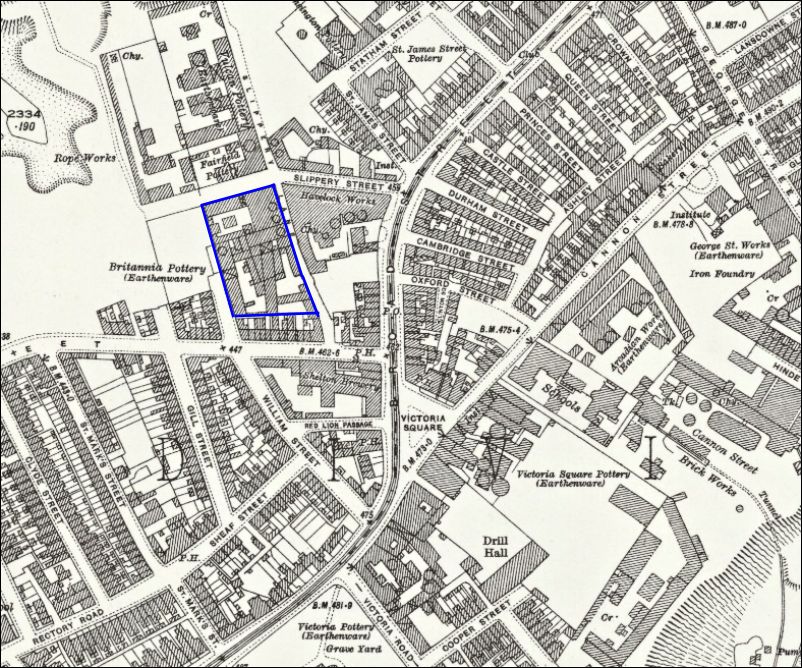
1925 OS map showing the
Britannia Pottery
courtesy: National Library of Scotland
at this time the works were operated by Electrical and Ordnance Accessories
photo: Bert Bentley
Collection, Stoke-on-Trent City Archives
Staffordshire
Past Track
Britannia Villa
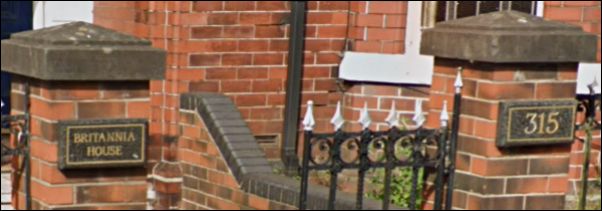
Britannia House
315 Princes Road, Penkhull, Stoke-on-Trent
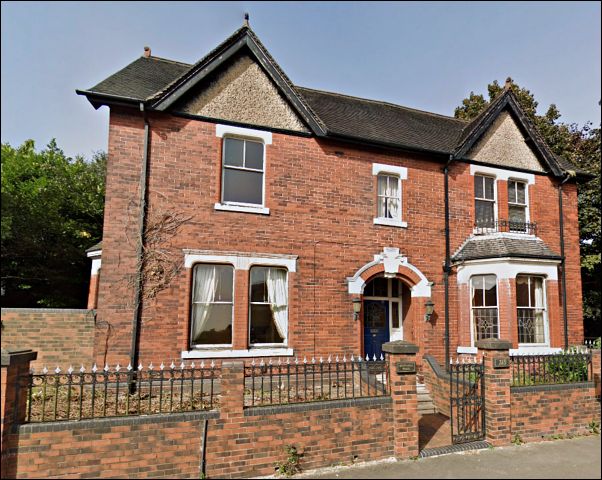
Home of
Joseph Gray, pottery manufacturer originally called 'Britannia Villa',
named after his factory 'Britannia Pottery'
photo: Google Street View
The London Gazette
25th August 1925
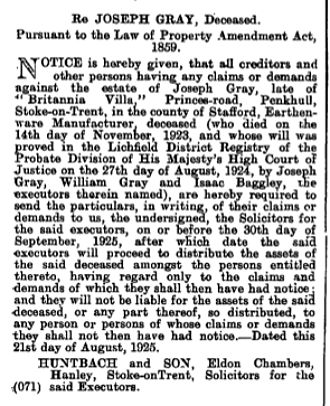
notice to
persons having claim against the estate of
Joseph Gray who died on the 14th November 1923
the executors were Joseph Gray, William Gray and Isaac Baggley
Questions, comments, contributions: email: Steve Birks